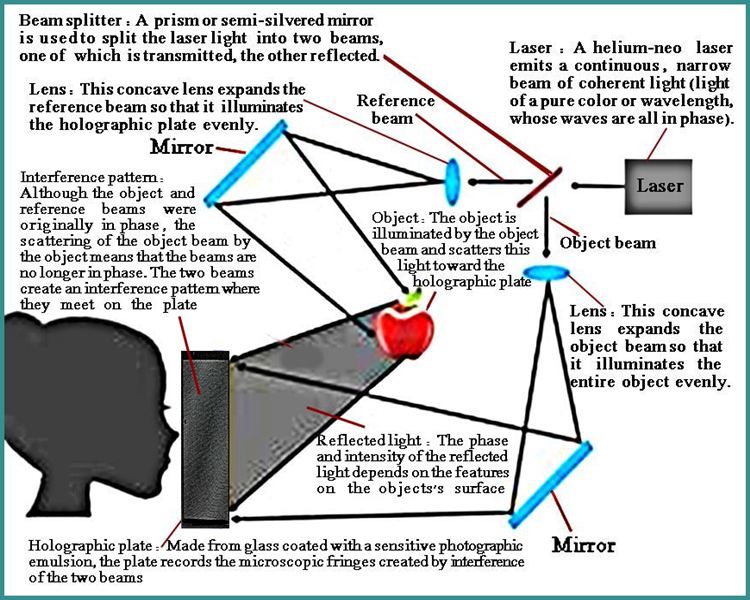Capturing the Moments
Photographic film
===============================
Photographic film is produced today in a huge assortment of forms. These include black-and-white
and color , slide, negative (print), and "instant-print" films. Films also come in different sizes and
formats, including APS (Advanced Photo System) and 35-mm cassettes and huge spools of film
for professional cinematographers. Most types of films have different speeds (degrees of light sensitivity).
At the heart of any film is a layer or layers of gelatin emulsion that contain billion of grains of light-sensitive
silver compounds called silver halides. The grains are sensitized to undergo a chemical change when
exposed to light of any wavelengths (black-and-white film), or a particular range of wavelengths (color).
During development of negative films, chemical reactions produce silver (in most black-and-white films) or
dyes (color films) in areas where grains were exposed. A similar process is then used to produce a print
on photographic paper from the developed negative.
In color-slide film, dyes appear only in unexposed areas of the emulsion during development. This process
is called color reversal. The result is a tri-layered transparency containing yellow, magenta, and cyan dyes
that combine to produce the original scene. A patch of green in the original scene, for example, expose only
the middle layer of the transparency, producing no dye, while in the other, unexposed layers, yellow and cyan
dyes are released and these combine to produce green.
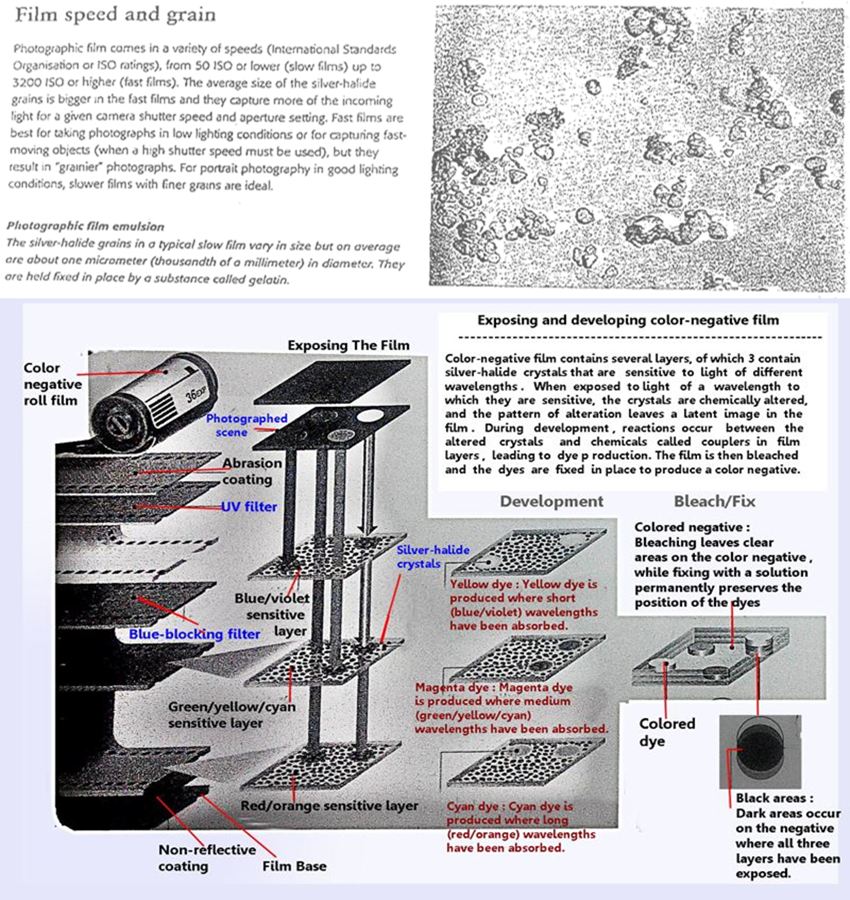
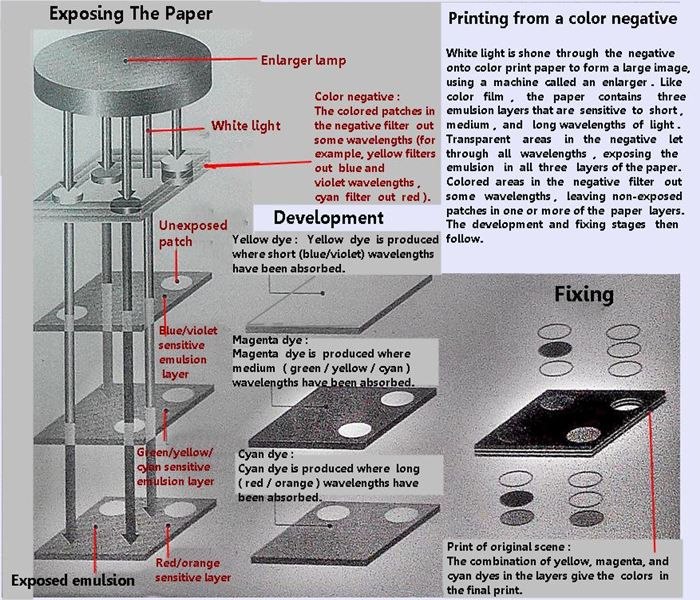
Cameras
-------------------------
Although modern cameras are computerized to allow photographs to be taken in difficult
conditions by simply pointing and shooting , a camera is quite simple in principle. It comprises
a light-tight body to hold the film and transport mechanism (or light-sensitive chip, in a digital camera),
a lens to focus the image, an adjustable aperture (window) to admit light, and a shutter that opens for
a preset time.
The two main types of cameras are the single lens reflex (SLR) and the compact. Compacts are light,
small, highly automated, and easy to use. Modern SLRs are highly automated too, but offer the
photographer more control over the picture because the aperture, shutter speed, focus, and other
settings can be manually overridden. Additionally, a wide range of lenses can be fitted to an SLR body.
Modern cameras are microprocessor-based devices. Sensors detect the amount of light entering the
camera. This data is used to set an appropriate aperture size and shutter speed, and charge a flash unit
(if present) when extra illumination is needed. Auto-focus systems measure the distance to the subject
using infrared or ultrasonic beams and move a motorized lens to focus the image. Many conventional film
camera have a motor to wind the film.
Digital cameras use an array of light-sensitive elements on a chip to record images, which can then be
output to a computer for manipulation and archiving. Most digital cameras are compacts, though digital
SLRs are increasingly being used by professionals.


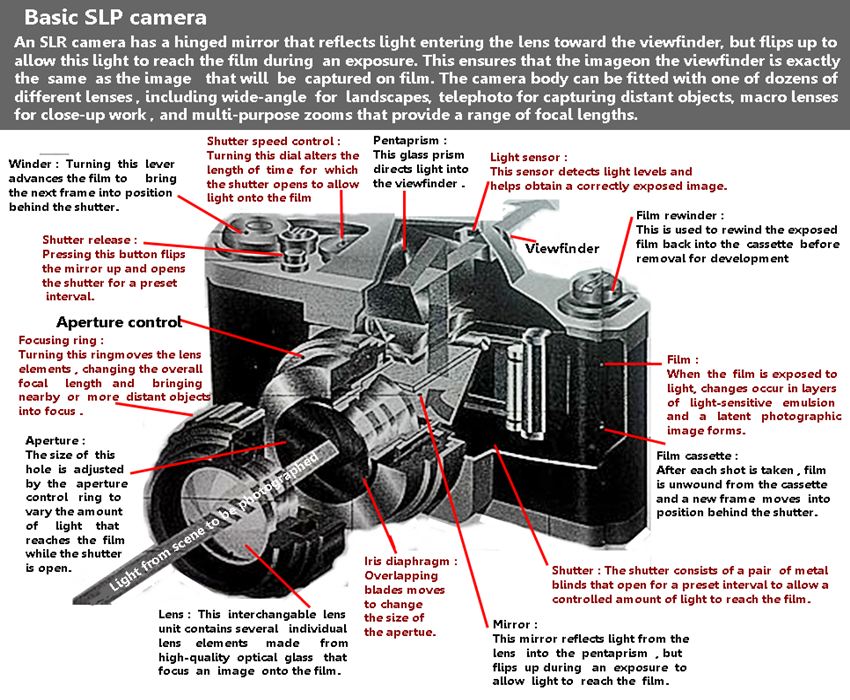
Movie cameras and projectors
=======================================
Motion pictures exploit a feature of human sight called persistence of vision, whereby images are
retained momentarily even after the object being viewed has changed. Movie cameras and projectors
use the same principles and technology to record and display a succession of still images , or frames,
at a rate of 24 frames per second, fast enough to generate the impression of smooth, live movement.
In order to capture or project a succession of still images, movie cameras and projectors advance a
length of film frame by frame past a device called a gate. Each frame is held still in the gate for a fraction
of a second, in which time it is exposed to light by a rotating shutter. In both cameras and projectors, the
shutter allows light to reach the film frame only when it is in position in the gate, shutting out light while the
film advances. A claw mechanism engages sprocket holes in the film to synchronize frame advance with
the rotation of the shutter. The film soundtrack is recorded as an optical or magnetic pattern along the
edges of the film during editing and is read by sound heads in the projector.
Modern trends in movie cameras and projection include digital cinema and large-format films, such as
IMAX. An IMAX projector is powered by a 15,000-watt short-arc xenon lamp, which is about five times
brighter than a conventional projector lamp, in order to create sharper and brighter images.
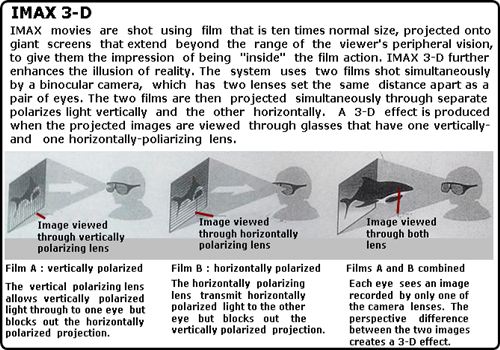
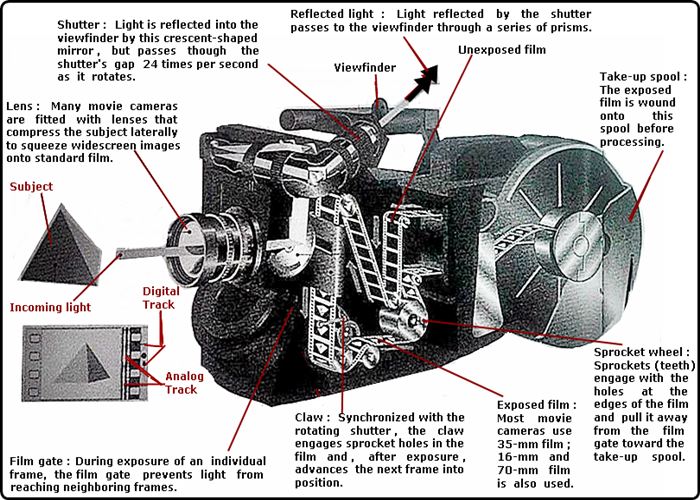
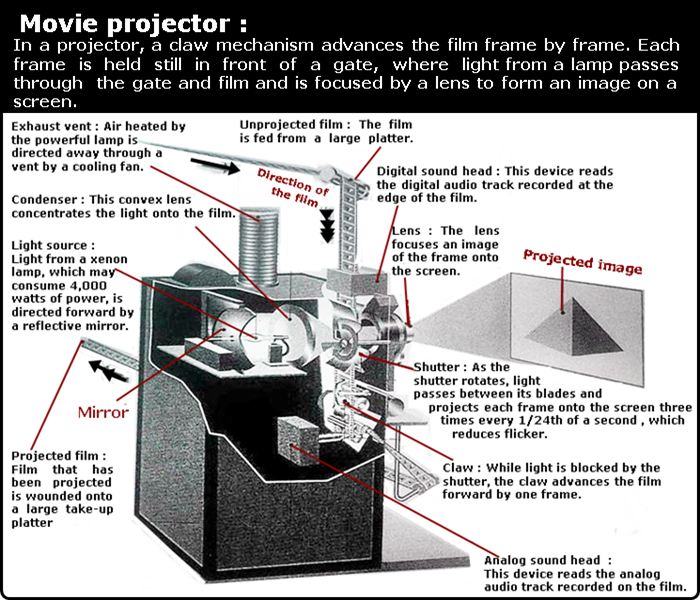
Digital cinema
================
Digital cinema technology does away with celluloid film and traditional methods of projection. Along
with the loss of the film go flicker, scratches, focus flutter, color deterioration, and a whole range of
degenerative processes that reduce the quality of a film the more it is projected. Future film-goers
will enjoy a clearer , brighter, more colorful picture, bringing them closer to the vision of the filmmaker.
Traditional cinema-projection methods shine bright light through a transparent film medium that holds
the image information. Digital cinema technology stores image information in digital form rather than
on film and must therefore process light inside the projector. This has been accomplished with the
development of Digital Light Processing (DPL) Cinema technology. DPL uses arrays of microscopic
mirrors, called Digital Micro-mirror Devices (DMDs) that move in response to the digital image information.
Bright light is shone onto these arrays and the light reflected forms an image. A succession of image
frames shown at a rate of 24 per second gives the impression of a moving picture. Digital-format movies
are either recorded in electronic form using a digital camera or converted from film into digital code.
The conversion process involves taking each frame of a film and splitting it into red, green, and blue
components. Each frame is divided into small pixels (picture elements) and the intensity of each color
in each pixel is measured. The intensity values are recorded as digital data and saved onto hard disk.
Digital motion pictures can be sent to movie theaters along broadband cable connections or beamed
globally by satellite.
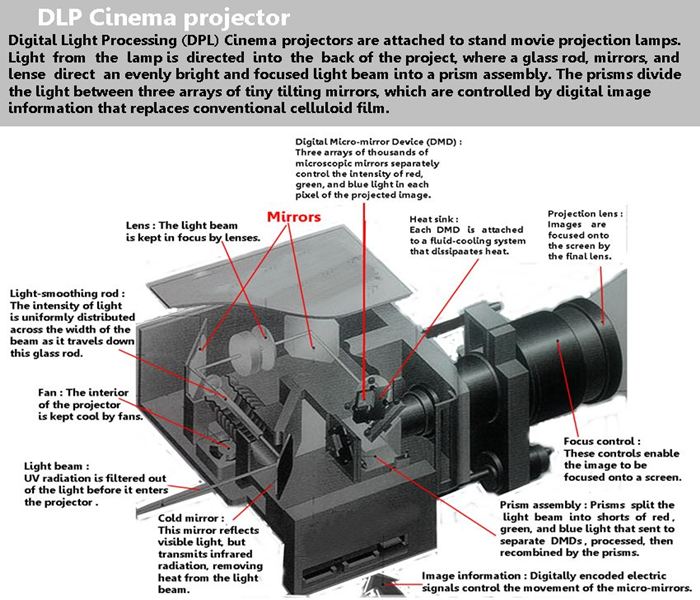
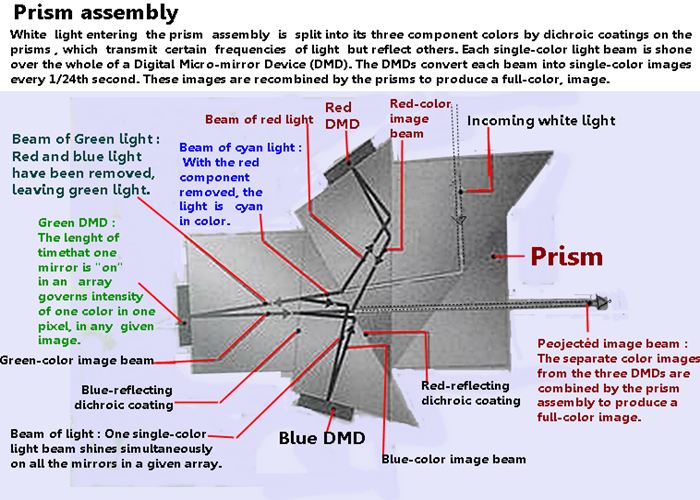
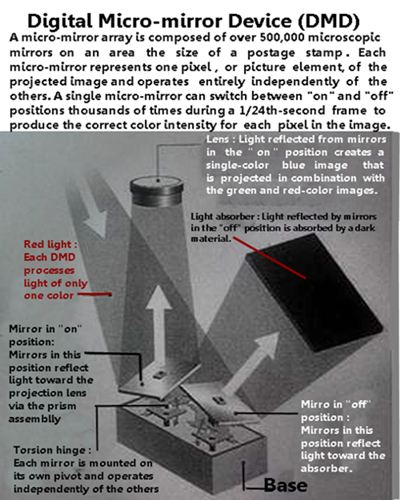
Video Technology Part 1)
=======================
Video technology involves the electronic capture , recording, and playback of a sequence
of still images and sound. Most video devices process and store this information in analog
form, as continuously varying electric currents and magnetic patterns on tape. Digital video
equipment encodes images and sound as discrete binary pulses for manipulation by
computer and storage on tape , disk, or microchips.
Video recording involves converting moving captured by a camera into a signal that comprises
30 frames (complete still images) for each second recorded. The electric signal can be recorded
on magnetic tape. Each frame is divided into several hundred horizontal lines. A single frame is
stored as two interlaced fields (half frames), each of which contains data for alternate lines of the
image. A television set drawn 60 fields per seconds, line by line, giving the illusion of a moving picture.
Traditional TV cameras use filters to split the image into three primary-color images. These images
are scanned line by line using photo-multiplier tubes, which generate an electric current in proportion
to the brightness of the incident light. Today, images are more likely to be captured with CCDs instead
of tubes.
Video signals are recorded in a range of formats on various meida, including VHS, 8-mm, and DV
(digital video) tapes and DVD (digital versatile disks). Digital video recording must be converted into
analog form for display on current TV sets.
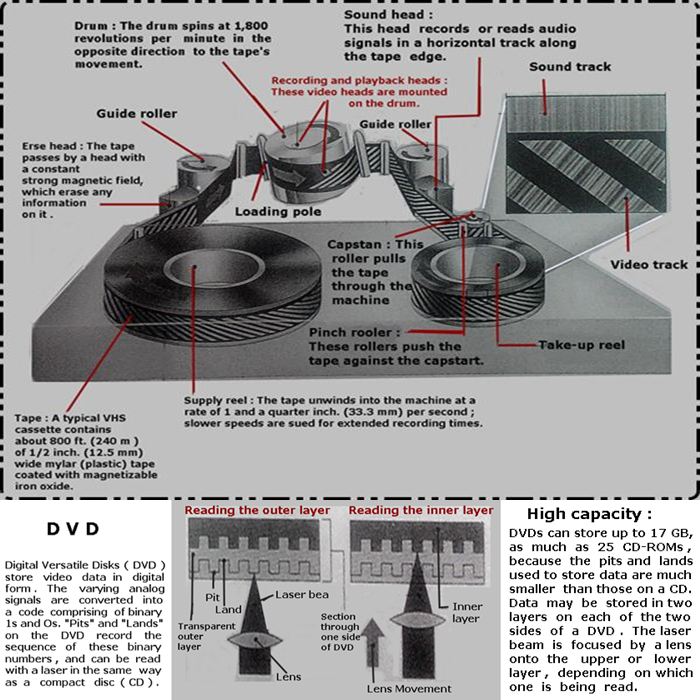
Video recording and playback :
-------------------------------------------------
When a cassette is inserted into a video-cassette recorder (VCR) ,
a loop of tape is pulled out of it by the loading mechanism. The tape winds around a set of rollers and
heads , which are coils of wire that record a magnetic pattern on the tape when an electric signal
passes through them, or produce an electric signal as the magnetized tape moves past during playback.
Separate heads are used for audio and video recording and playback.
1) Tracks on a videotape :
----------------------------------------------
On analog videotape, the magnetic particles in each track form wavy patterns in various
directions. On digital videotape, they align in only two ways, representing 1s and Os.
2) Inside a VHS video-cassette recorder (VCR) :
---------------------------------------------------------------------------------
A system called helical scanning is used to record picture information in diagonal tracks across the tape.
Two or more recording heads on a rapidly spinning drum cause magnetic particles on the tape to line
up. As one head reaches the edge of the tape, another begins to write a new track parallel to the last.
The sound signal is recorded along the tape edge.
Video Technology (Part 2 : Electronic images )
===========================================
Electronic images :
--------------------------------------------------
The charge-coupled device, or CCD, lies at the heart of the modern video camera. It is a silicon
semiconductor chip that collects electric charges in millions of tiny squares called pixels, in
proportion to the amount of light falling on it. The charges can then be flushed out of the CCD in
sequence, transforming the picture information into a varying electric current. A typical CCD
repeats this process 30 times every second.
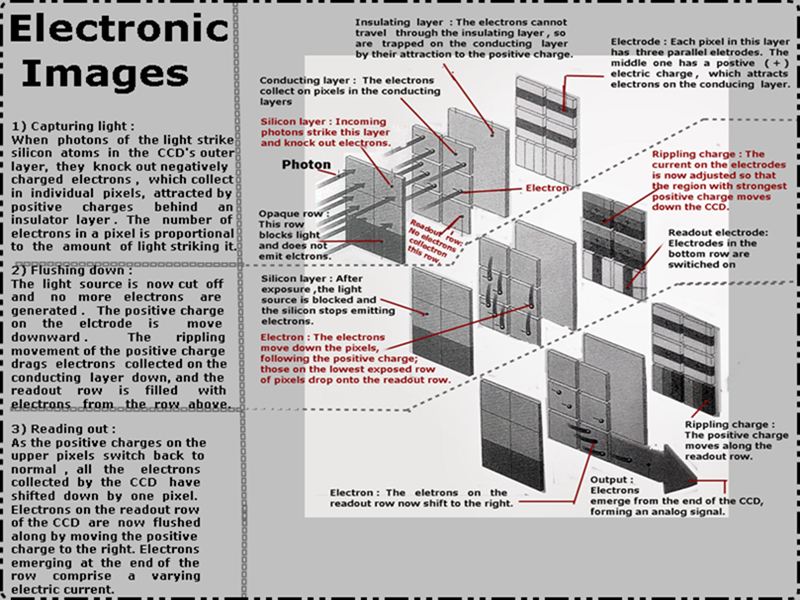
Holography
============
Holograms are familiar as 3-D photographs and as the multi-colored security emblems
on credit cards and CD packages. The theory of holography was developed in 1948 by
Dennis Gabor, who coined the word "hologram" from the Greek words holos ("whole")
and gramma ("message") , but holography became a practical possibility only after the
development of the laser in the 1960s.
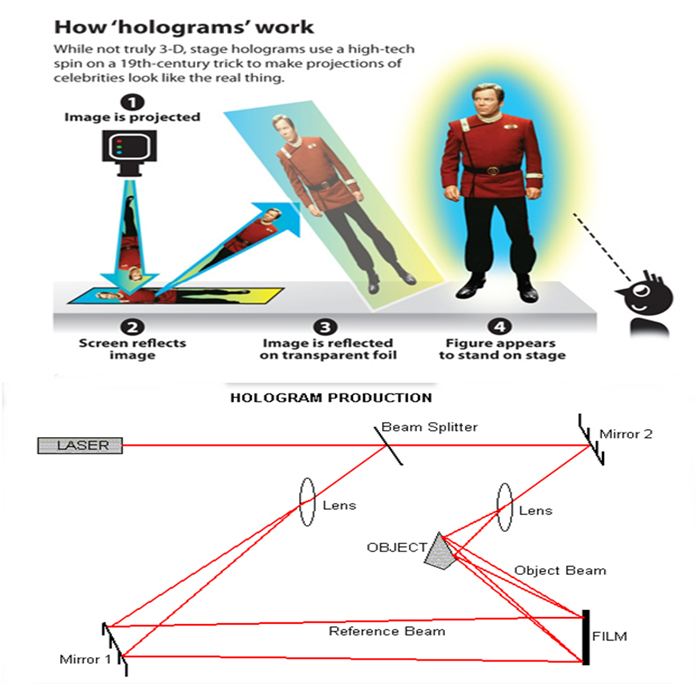
Hologram
============
A hologram is a photograph of an interference pattern created by the interaction of
light beams. Unlike a standard photograph, which is a direct copy of its subject, the
image on a holographic plate looks nothing like its subject. Instead, it is made of light
and dark fringes, which contain information about the light that traveled from the object
being imaged to the plate, including its phase (whether the light waves were in step or not).
The phase information is what gives holograms their depth, and allows the viewer to
"see around" parts of the image . A laser is used to make holograms because it provides
the required coherent light ( light whose waves are all in phase ). When a hologram is viewed,
the fringes diffract (bend) light waves striking them, so that they appear to have come from the
original object.
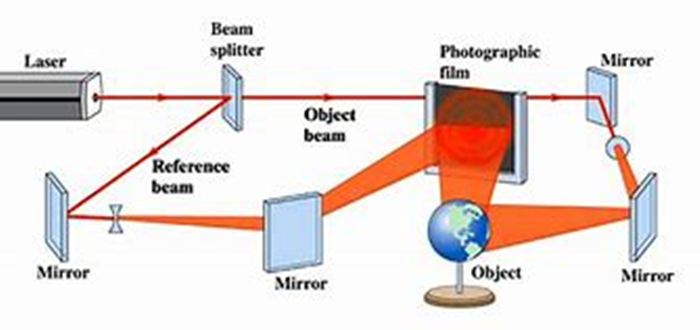
Holography in Art and Entertainment
===================================
Holography is widely used in scientific research and testing. Holographic labels
are used in scientific devices because they are difficult to forge. Other applications
include aircraft head-up displays, which project images of instruments into the pilot's
field of vision, and bar-code scanners in stores. And if optical computers, based on
optical pulses instead of electric signals, became a reality, they will rely on
holographic technology.
Apart from its use in critical scientific research and sensitive commercial applications
such as security , holography has been developed into an art form, and holograms are
found in museums and galleries worldwide. Holograms can be mass-produced cheaply
enough to be used for gifts and novelties. The entertainment industry is awaiting the
development of full-motion holography, but the technology to make holographic TV
programs, motion pictures, and computer games has not reached maturity yet.
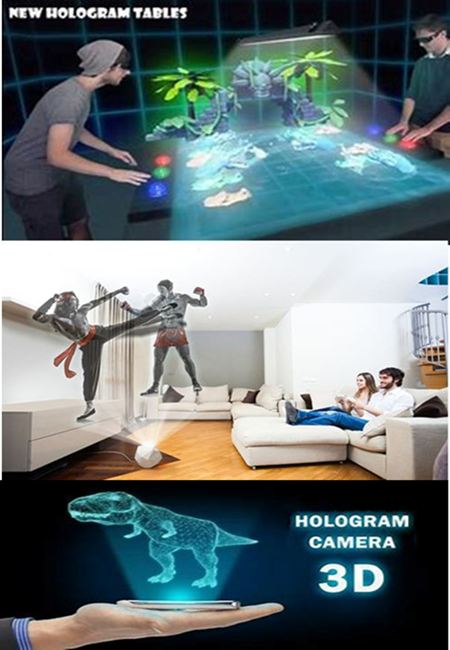
Viewing Holograms
======================
The interference pattern on a holographic plate diffracts (bend) light shone on it.
This creates a 3-D image by reconstructing light rays as originally scattered by
the object. Reflection holograms are lit from the front of the plate. Transmission
holograms are usually lit from the behind the plate, but some, such as those on
credit cards, are embossed on reflective film so that they can be lit from the front.
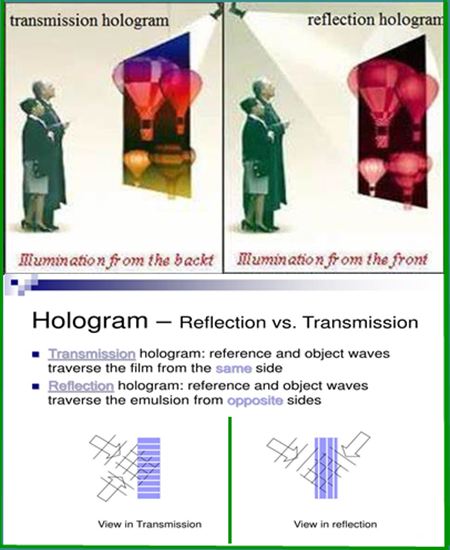
Holographic Camera
=======================
This holographic camera is used to make a type of hologram called a
transmission hologram. Light from a laser source is split into two beams.
One beam : the reference beam is directed onto a photo-sensitive plate,
while the second beam, the object beam, reaches the plate after being
reflected from the object being imaged. The two beams interfere to create
a pattern of fringes on the plate. Since the interference pattern must be
recorded in very sharp detail, and the exposure time may be long, vibration
must be minimized, so the equipment is secured to a very heavy base.
